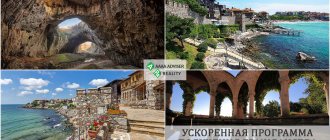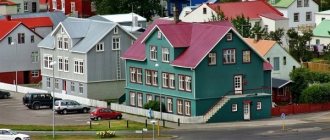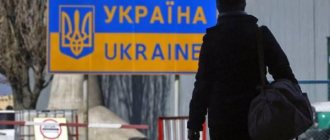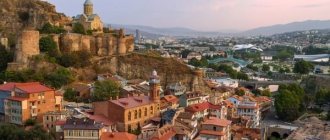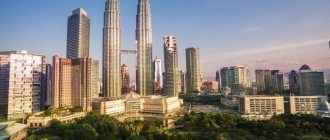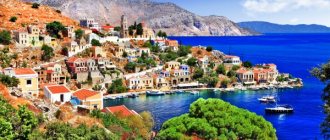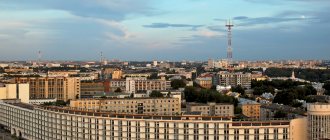Immigration to Estonia has been of interest to residents of Russia for quite a long time, since the mentality of this country is very close to ours. Residents of the Russian Federation are increasingly using this state to move to the European Union and develop business, since it is part of the EU, NATO and is a party to the Schengen Agreement. Since this country borders Russia, it is much easier to realize your intentions from its territory.
View of Tallinn, the capital of Estonia
Advantages of emigrating to Estonia
Estonia is an independent European country with a good economic and geographical position, bordering the Baltic Sea. In 2004, it was admitted to the EU, and to maintain rapid economic growth, the organization periodically provides financial assistance to the state. Estonia has very strict immigration laws, making it difficult to enter the country.
Some benefits for moving to this state are available to people whose relatives lived on its territory and were citizens of Estonia from 1918 to 1940. The maximum number of people allowed to cross the borders of this country is 0.1% of the total population, which is approximately 1,400 people.
In most cases, it is impossible to become a citizen of this state without permanent residence in Estonia. But having at least a residence permit, a person can be equated to a native resident of the country.
This is what a driver's license looks like in Estonia
The governance system in Estonia is parliamentary. The country has a national language that is completely different from other languages of nearby countries. The main advantages of emigrating to the former republic of the USSR are the presence of a large number of Russian-speaking residents on its territory, proximity to Russia and quick adaptation to the new area.
Having a residence permit in Estonia, you are allowed to move freely throughout the European Union countries that are part of the Schengen zone. Also in this state there is no income tax, but social contributions, fees from individuals and VAT are quite high.
State immigration legislation is fairly neutral regarding residents from Russia, and therefore to enter this country you can use one of several options:
- Enter into an official marriage with a resident of Estonia.
- Get a job in this country.
- Business immigration to Estonia and development of your own company.
- Enter one of the higher educational institutions of this state.
- Purchase real estate.
Estonian citizenship
But even despite some disadvantages, emigrants strive not only to leave for Estonia for a while, but also to obtain citizenship in this country. An application for citizenship is submitted after three years of residence for permanent residence in Estonia. All documents are sent to the Bureau of Citizenship and Immigration Affairs. Among the requirements for the candidate:
- proof of income;
- availability of real estate;
- passed an exam on knowledge of the language, as well as the history of the state and its constitution;
- renunciation of first citizenship (dual citizenship is prohibited in Estonia).
The package of necessary documents includes:
- questionnaire;
- international passport;
- photo;
- fingerprints;
- certificates of education and military service;
- check for payment of state duty (13 euros).
Within 30 days, the authorities make a decision and, if the answer is positive, the foreigner is issued an Estonian passport.
For several years now, Estonia has had such a concept as “electronic citizenship” (it costs 200 euros). It involves creating ID residents through an electronic signature. The holder of such citizenship has the right to conduct activities in the country in a digital format: conduct financial transactions, enter into contracts, pay with cryptocurrency, etc.
Entering the country to open a business
Emigrating to Estonia from Russia to develop your own business has many advantages.
The most important thing is that this procedure is not very expensive compared to other countries of the European Union. Estonia has relatively low taxes, and its economy welcomes entrepreneurs from other countries. Any investment from abroad is welcome here.
Emigrants are allowed to register a joint-stock company or limited liability company in this country. After this, a residence permit in Estonia is automatically granted for two years, which can subsequently be extended for five years.
In order to extend a residence permit, the company must conduct business activities for 8 months before submitting the application.
In Estonia, emigrants or foreign legal entities are allowed to register two types of companies: a joint stock company and an analogue of an LLC. The first option requires an authorized capital of more than 25,000 euros. To register a limited liability company you will need to pay ten times less.
business investment growth chart in Estonia
A mandatory requirement in both options is that the company’s authorized capital must be located in any bank in Estonia. Only after this the owner of the company can freely use his funds.
In addition to the initial investment, when registering a company, you will have to incur some other expenses. You will need to pay various state fees and several mandatory payments. In total, the amount will be approximately 2000 euros.
It is important to know that when involving law firms that specialize in registering companies, the cost of paying for such services can range from 4,000 to 6,000 euros. The cost depends on the type of enterprise and legal status.
But when registering a company through a specialized company, the customer in any case must be present at the registration of the company to sign documents, have them certified by a notary and invest an amount of money in an Estonian bank, which is equal to the authorized capital of the future company.
Notary office building in Tallinn
Also, among the advantages and disadvantages of running your own business in Estonia, one can highlight the fairly low cost of this process.
Estonia has a fairly flexible tax policy, since there is no income tax, and 18% VAT is charged only if the company’s annual turnover is more than 16,000 euros.
Also, 35% of the enterprise’s commercial activities will have to be paid to the state budget.
In addition, you do not need to take over the management of the company yourself. It is required to select an executive director and monitor the work of the company remotely, without even being in the country. Having registered your own enterprise, from the beginning of official work you can buy any real estate, transport and land.
Relocation to Estonia: How to move during a pandemic?
03/18/2021 RUBRIC: Relocation
Author: Yulia Kholina
11338
Yulia Kholina and Yura Teslya are a couple of IT specialists from Kharkov. The guys liked living in Ukraine, but from their next trip they brought back the idea that it would be interesting to try living and working in Europe in order to understand the peculiarities of the mentality and approaches to life. The choice fell on Estonia.
Moving to Estonia for IT specialists is so easy that it could even be boring. But it was in 2020, and a whole series turned out: a goal, on the way to which huge obstacles arise one after another, and the main characters who, through chaos and several depressive episodes, achieve their goal.
Why Estonia?
In the fall of 2019 (I don’t remember what triggered it: maybe another shutdown of water or heating?) we finally moved from talking about “it would be nice to live in a European country” to a specific “let’s move!” Then we didn’t yet know where exactly we wanted to go. So we began a period of looking through the articles and blogs we read, trying to figure out which country best aligned with our values. We discussed and argued a lot, until at one point we simply remembered Estonia. And at that very moment I felt – this is it!
The most important reason why Estonia seemed like a good option to us is its developed IT sector, and we would also like to include new career opportunities in our move. “European Silicon Valley” - the forums about IT in Estonia loudly responded. Digitalization in all spheres of life looked no less attractive. The blogs said that there is no bureaucracy in the country at all, you can get any paper online, and you can sign anything with a digital signature. We had a hard time believing it, but it was interesting to try. Another significant factor is a good environmental situation, adherence to the concept of work-life balance, and the popularity of sports. An additional argument on my part was living in a relatively small city (Tallinn’s population is 430 thousand); I was pretty tired of living in a big city, when walking to work was the same as driving through morning traffic jams, when a standard day spends an average of 12 hours away from home: work, training, English, meetings and time to get to them, when traveling to another area was considered an unaffordable luxury due to the amount of time it took.
How to find a job?
Some background data: at the time of the move, each of us had more than three years of experience as a Software QA Automation Engineer, good English (B2) and sparkling eyes. Each of these factors played a very important role in receiving a job offer.
Looking for a job in Estonian IT is a very pleasant experience. First, the process of searching for vacancies: we went to our first interviews thanks to the MeetFrank application, an Estonian startup, of course. There you only need to tell the application about your knowledge, desired position and salary expectations, after which Frank himself will send relevant job offers, even indicating the approximate salary bracket. Secondly, the interviews themselves were very different in a positive direction from our Ukrainian experience - no mountain of theory, which definitely won’t be useful in work, almost always it’s more of a conversation where they ask you about your experience and discuss the technical assignment done at home.
Although strange stories have also happened, you need to be prepared for them, especially when you go for an interview at a small startup: they simply may not have a separate person responsible for hiring and possessing the necessary skills for an interview. For example, in one of the companies, in response to my request to tell me more about the vacancy, they shouted at me, saying that this was already clear from the site, hadn’t I read? Happenes.
In general, it was not difficult to find a job; the choice of vacancies was quite large. The main resources for searching are the mentioned app MeetFrank (free for job seekers), Glassdoor, WorkInEstionia. The only adjustment that 2020 made was that much fewer companies were willing to transport people from other countries. My typical refusal from April of this ill-fated year sounded like this: “You have relevant experience and a perfectly completed test task, but now we have decided to focus on local market candidates.” Now the situation has already improved greatly, but, as I understand it, it has not fully recovered. At the same time, Estonia has already changed legislation several times to simplify the relocation of specialists during the pandemic. And they are about to sign a new law that will allow entry in some cases on a spouse’s work visa (before this it was possible to bring a family only with a residence permit).
The period of received offers (job offers), May 2020, coincided with the end of the state of emergency in Estonia. There was no clarity: our HR specialists, mine and my husband’s, told us different facts about the opportunity to come, which did not fit into one logical chain, and even contradicted the information that we found ourselves.
Our suitcases had been packed for about a month; we had moved to our parents from a rented apartment and were languishing in painful anticipation. Flights Kyiv - Tallinn were canceled and resumed three times a week, the situation in the world looked about the same, it was scary to plan a flight with a transfer: it was not enough to get stuck somewhere in a European airport. At some point, I simply bought plane tickets to Tallinn from Kyiv. We eventually flew away on it.
“We’ve had our suitcases packed for about a month now.”
To make this possible, employers sent us contracts. In addition to this, we needed to obtain entry permission from the Estonian police, for this we needed to justify the reason and attach documents (contract and passport in our case) in an email. In fact, the response to this email is the most important document for entering the country. But even despite all this, in Zhulyany we spent a fair amount of time trying to prove to the airport staff that we had the right to enter Estonia. There were explanations, arguments, conversations with the “senior”, and after an hour of bickering we were finally allowed on the plane. The visa-free regime with the European Union has greatly simplified our life, given that the Estonian Embassy in Ukraine resumed its work only closer to autumn.
How to obtain a residence permit?
In Estonia, you can obtain a residence permit using a simplified procedure in certain cases. For example, if you come to work at a startup or engage in research activities. Or if you are a top specialist (such a specialist is determined by the size of his salary, more information here).
A residence permit is issued for 5 years if you receive it as a top specialist, but it is tied to the employer - if you change jobs, you need to change the residence permit. If the job is not available within a month after dismissal, Estonia will oblige you to leave the country.
The process of applying for a residence permit was too easy to be true. The only documents needed are a completed application form, a passport and a payment receipt. On the spot they take photographs, take fingerprints, check your profile - and that’s it. That is absolutely everything! The whole process took 15 minutes, with the caveat that you had to sign up on the website so as not to stand in line. Although the impression is spoiled by the news that you will have to wait up to three months for the document.
Housing
For the first time, my husband’s company rented an apartment for us (often included in the relocation package), but we wanted to quickly unpack our already tired suitcases, so we started looking for something for long-term rental first of all after leaving quarantine. Finding good housing is quite simple, but there are pitfalls - the services of a realtor are equal to the amount of monthly rent, plus you will have to pay a deposit in the same amount. Although in fact, if you wish, you can find options where you don’t have to pay either one or the other, but we learned this, of course, much later. The choice of apartments is large, for every taste and budget; prices for comfortable housing for a couple start from € 500.
Another point that is worth clarifying when talking with the landlord is whether it will be possible to register your place of residence here. Without this, you won’t be able to use the benefits for city residents, for example, free public transport.
Our favorite area is Haabersti. The sea, several beaches, forests and walking trails are very close here. They bet that during a period when one lockdown follows another, it is more convenient to live near a cool walking infrastructure than near an office. Moreover, the public transport system works well; the office in the center can be conveniently reached from any area.
“When one lockdown follows another, it is more convenient to live near a cool walking infrastructure than near an office”
One of the interesting features of the apartments themselves is that air conditioning is rather rare here; summers are simply not so hot that the room requires cooling. But you can often find a sauna in apartments. In our case, two of the three apartments we looked at had electric saunas.
Adaptation
The first three months were quite difficult, which is remarkable, precisely because of that very digitalization. A huge number of things in this country are tied to your ID card (aka residence permit for visitors), which are inaccessible without it. One of the most annoying is online banking. We couldn’t pay for anything online: apartment rent, utilities, internet, any other payment to an Estonian account was made for us by friends, for which we were very grateful to them.
But in terms of language, it’s great here: in Estonia, most of the population speaks English very well. The remaining part is almost 100% likely to understand and be able to respond in Russian. Most Estonian websites have three localizations – Estonian, English, Russian. The only place where sometimes we feel helpless without Google translate is the supermarket. It seems that we have been blessed many times already by the creators of the automatic language detection function, it is precisely this that helps us not to go crazy when we find ourselves in a store with a very specific request like “need corn starch” and have already made several circles around the building in search of the necessary packaging. I think this gives a good idea that adaptation was easy for us, since such little things occupy us.
I'm learning Estonian. Would it be possible to do without him here? In theory, yes, if you are not applying for a permanent residence permit or citizenship - for this you need to pass a language exam. To me, however, it seems like a necessary part of the integration process. I feel like I understand everything that’s happening here better after every Estonian lesson and I enjoy it. Although we must admit that learning Estonian is a great exciting adventure, full of difficulties and surprises, because it belongs to the Finno-Ugric group of languages.
New habits: transport and electronic document management
No extra paperwork! The people on the forums were right. Trips to government agencies and “important” papers with stamps have mysteriously disappeared from our lives. It feels absolutely amazing: while we are still wondering what to do with the freed up time that was allocated for knocking on doorsteps and intense visits to all sorts of authorities. We’ll probably get used to it later, but for now we feel a burst of joy every time we can simply find the necessary information on the website or, for example, submit a tax return by pressing one button there.
We can illustrate these words with a story about the change of rights. Our Ukrainian driver's licenses needed to be exchanged for Estonian ones within a year. We signed up for a visit to the highway department, we only needed our old license and an Estonian ID card with us, the whole procedure took about 20 minutes, we could pay for it with a card without leaving our seats. A week later they came for new documents without an appointment, they took them in 10 minutes. That's all. Not only that, but they weren’t even rude even once. This is, of course, completely prohibitive.
Speaking of cards. The last time I withdrew money from an ATM, it seems, was before I received my ID card. There was simply never a need for more. It still amazes me when terminals are found everywhere: even in the market, even in front of the entrance to a godforsaken lighthouse. And every time my question about whether it is possible to pay by card is met almost with resentment: of course, how could it be otherwise? Most of the banks here are cashless, i.e. no cash. You cannot physically bring money and deposit it into your account or pay in cash for the service - only by card.
Use your car less. In Tallinn, travel on public transport is free for residents of Tallinn (in Tartu - for residents of Tartu, etc.). Buses, trolleybuses and trams look cool (the latter, by the way, can be admired in the movie “Tenet”), are comfortable, and run on schedule. One day my bus was 2 minutes late, and I was worried that now I wouldn’t make it anywhere and my plans were ruined. This is probably a story about how you quickly get used to good things.
This system really encourages people to use cars less in everyday life. For what? With a bus, you know exactly how long the journey will take you, it’s free, and you can also have time to read the news or a book during the process. In warm weather, it’s convenient to get there by bicycle or electric scooter, of which there are plenty of them anywhere in the city; you can easily rent them in the app.
New habits: medicine and safety
Trust in medicine. There was no need to get to know her closely, but the way the country is coping with the pandemic inspires confidence. There are many testing points, some of them drive-in - an analysis is taken from a person directly from the car. Results are processed relatively quickly. In case of symptoms of illness or returning from another country, tests are free. A consultation with a family doctor and an appointment for a test can be obtained directly by phone; there is no need to stand in line. The state reacts quickly to changes in statistics: it introduces or removes restrictions, creates additional beds in hospitals, etc.
Medicine is mostly free, completely free for children under 18 and pregnant women. Although it is important to note here that it becomes such only after receiving a residence permit, before that you need to purchase insurance yourself (again, we were covered by the employer as part of the relocation package). There are also paid clinics here, but they are few. From personal impressions of the healthcare system, only the appearance of our family clinic: “This could very well turn out to be some kind of contemporary art gallery.”
Wear a reflector. When we first arrived in Estonia, we were struck by a strange feature - all the people wore some kind of labels on their jackets. We suspected that they just wanted to return them to the store, on the other hand, are they really all such cheapskates? The solution was discovered by chance when my husband was sent a large guide on relocation. Literally on the first page we saw a note that wearing reflective elements at night is mandatory and you can be fined for not wearing them. We really liked the idea: a very small round piece that costs a few euros, but at the same time makes a pedestrian many times more visible to drivers at night. This greatly improves overall road safety. Now each member of our family, including the dog, has a couple of reflectors and a reduced sense of anxiety.
Nature and level of stress
Restore strength in nature. In Ukraine, several times in the warm season we went out to barbecues or something like that. In Estonia, I didn’t even catch the moment of transformation, but on any day off we find ourselves somewhere on a forest path, spending time in national parks or walking near the sea. On the one hand, this is relevant at a time when contacts need to be limited, on the other hand, it’s all so incredibly beautiful and very filling. What is important is that the infrastructure for such walks here is excellent. There is even an application where you can find all the walking trails, places for making a fire and camping, as well as a description of all the hikes.
“On any of our days off we find ourselves somewhere on a forest path”
Stop being angry . This point is perhaps the most difficult to explain. The bottom line is that here our level of household stress has greatly decreased. These are all such banal things that, it would seem, you don’t even notice, but in fact they affect your well-being and general perception of life. For example, the heating was turned on on the first day when it got cold, and since then it has not failed. Like water, electricity, and even the Internet. Or from another sphere - in all the time we have lived here, we have only heard the sound of a car horn once, the drivers are polite and very calm, there are no traffic jams, the journey to work by car does not cost you a single nerve cell. There are queues in supermarkets only on Friday evenings. These are minor things, but globally – a low crime rate, a normally functioning police force, which there is no reason to fear if you don’t break the law.
Minuses
So that the picture does not seem idealized, we will also tell you about the disadvantages or unpleasant moments that we had to face:
Very short daylight hours in autumn and winter. From mid-October to mid-February we really missed the sun and light. It was unusual to see darkness for several hours after waking up and immediately after lunch. It's no wonder that reflectors were invented in neighboring Finland, since it's dark most of the day!
The amount of sun per month in winter is measured in hours. No joke, at the end of the month you can see headlines in the media like “Estonians got 11 hours of sun in January.”
The prices for services make the eye twitch. For example, food prices differ from Ukrainian prices by 15-20%, and this is normal. Prices for education and beauty services are at least three times higher, paid medical services are five times higher. We are trying to stop comparing and take it as a fact.
You can wait a very long time for delivery, unless it concerns food from a restaurant or groceries. Once, books from a store 8 km from our house were delivered three weeks after ordering. When ordering something more significant, like equipment, the minimum waiting period will be a week. But for little things there are nice delivery systems like parcel lockers or delivery robots.
Despite the disadvantages, we like Tallinn: from fashionable Telliskivi, where at the next table you can hear someone pitching a startup or the next cryptocurrency to someone, to nostalgically trashy Copley. Here we definitely managed to find a new interesting turn in our career and try a slightly different lifestyle, when we can not rush to do more, but calmly go towards our goals, having time to enjoy life along the way.
useful links
A large guide about all aspects of relocation in Estonia;
Website with vacancies and useful information about job search and relocation;
Telegram channel with useful information and funny stories about life in Estonia in Ukrainian;
Current restrictions and news related to coronavirus;
Chasing unicorns is a film that will help you understand the cultural context of Estonia in general and startups in particular. It is in Estonian, but there are English and Russian subtitles.
Photo: UnSplash
Tags: Estonia
11338
Attachments
One of the most popular ways to immigrate to this country from Russia is investing.
Sample residence permit card in Estonia
A residence permit in Estonia, without the opportunity to work, can be issued if the emigrant’s income allows him to fully support his living expenses.
At the same time, a foreigner needs to buy real estate at his own expense, which will allow him to apply for permanent residence after 5 years.
Job
Moving to Estonia from Russia to get a job is not an easy way to gain a foothold in this country. A residence permit can only be issued if the company initially conducted an interview for the vacancy, and after three weeks no resident of Estonia or a person with a residence permit, a citizen of the European Union, who would meet the stated requirements and qualifications of the company, has applied for it, except foreigner.
At the same time, the number of people wishing to obtain a residence permit in Estonia should not exceed 0.1% of the total population of the state. An emigrant must have education and work experience, as well as good health. Before completing the documents, the emigrant must obtain advance permission from the Unemployment Insurance Fund, which will be valid for 60 days from the date of registration.
Before submitting an application for a residence permit, the emigrant and the owner of the Estonian company must conclude an employment contract for a period of at least one year, or the employer must make an employment offer to the newcomer.
In this case, a legal contract is drawn up that binds the company and the employee for a period of 1 year. In this case, the residence permit is issued for two years with the possibility of extending it for a further five years.
Procedure for obtaining a residence permit
Documents are submitted to the Department and Border Guard. This can be done in person at the consulate or on the territory of Estonia, as well as by mail or e-mail.
To obtain an Estonian residence permit, you will also have to submit biometric data. Data is updated once every six years.
Children under 6 years old do not need to undergo biometrics.
Applications for a residence permit in Estonia are processed within two months, however, if difficulties arise during the registration process or if it is necessary to supplement the package of documents, the period may take a little longer, so it is recommended to submit applications in advance.
If the state gives a positive answer, you will receive a special plastic card. It is evidence of the legality of your stay in the country; it displays your data (including biometric ones).
Please note that a limited number of foreigners can obtain a residence permit in Estonia (no more than 0.1% of the total population).
Table: cost of obtaining a residence permit
| Applicant category | Applying in Estonia (EUR) | Applying abroad (EUR) |
| Child under one year old | 24 | 25 |
| Child under fifteen years old | 24 | Applications cannot be submitted abroad |
| Pensioners | 24 | Applications cannot be submitted abroad |
| Spouses of Estonian citizens | 31 | 50 |
| Workers | 96 | 120 |
| Entrepreneurs | 160 | 180 |
Features for children
If a child crosses the border with one parent, the consent of the second parent is required for the minor’s relocation. If one of the parents lives in Estonia as a resident or has citizenship of the country, he can send an invitation to the foreign child, which will significantly simplify the relocation procedure. In general, in order to bring a child into the country and subsequently carry out the procedure for processing documents for a minor, parents must present to the state documents proving the identity of the young immigrant and proof of relationship (usually a birth certificate is requested).
Pensioners
Estonia does not have a special program for elderly immigrants. This means that older people must meet all the requirements of the authorities: have reasons for moving, sufficient income, all the necessary documents, and so on. However, older people do not have many chances to get a job in Estonia, so pensioners usually move as family members of able-bodied applicants, if they have the right to bring relatives to Estonia.
Pensioners can move to the country on a general basis
Higher education and training in Estonia
Another way for visitors from Russia to obtain a residence permit is to study. Since Estonia is part of the European Union, higher education diplomas from its educational institutions are valued by all European countries.
The Estonian educational system is based on the Bologna process, in which a bachelor's degree is achieved in 3 years, and a master's degree can be obtained in another 2 years. To obtain a doctorate, you need to study for another 4 years.
There are three private and six public higher education institutions in Estonia. The University of Tartu is considered the country's first university. It is the largest classical state university in Estonia. At the moment, Estonian institutions offer about a hundred programs with an English bias. Throughout the entire period of study, emigrants have the opportunity to earn extra money.
Tartu University building in Estonia
This does not require special permission, as it is part of the educational process.
To obtain an Estonian student visa, you must present the entire package of documents, including an invitation from a higher education institution with confirmation of the student’s enrollment. A residence permit for students is granted for a period of one year until the end of their studies. If the expat continues to study at the same higher education institution, then the residence permit is extended for one year at a time.
How does it all begin?
Moving to Estonia for permanent residence from Russia is a multi-stage procedure. To navigate it, you first need to understand the official statuses. Today, Estonia is one of the countries that have concluded the Schengen agreement - there are 26 parties to the agreement in total. To enter Estonian territory, you must first obtain either a Schengen visa or a special national permit for long-term stay. Having arrived at the place, the foreigner must contact the immigration service, where a petition is drawn up. Based on this application, the authorities may grant a temporary residence permit. You shouldn’t expect to be served immediately as soon as a person arrives: as a rule, the queue is quite long. The most convenient option is to book the date of your visit in advance, and make sure that by this time the period of stay on your existing visa has not yet expired.
When planning to emigrate to Estonia, you need to clearly understand that at first you cannot count on more than a residence permit. Such a permit will have to be renewed every year, and for this it will be necessary to provide documentation that would officially confirm the status of the applicant. The duration of consideration of the application in most cases is no more than a couple of months. If the government authority decides to approve the application, the citizen receives an identification card. The cost of public services is determined by the characteristics of a particular case, the type of documentation that the foreigner requests.


